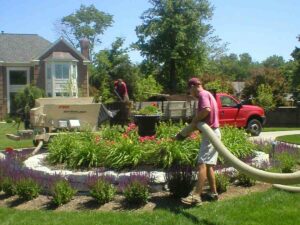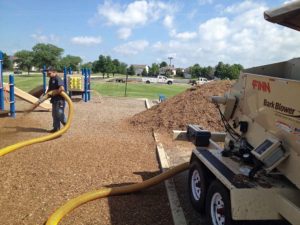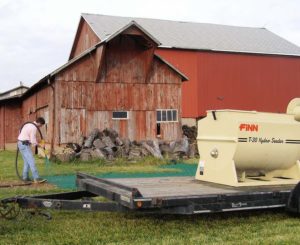Straw Blowers Can Do Much More Than Just Cover Seed
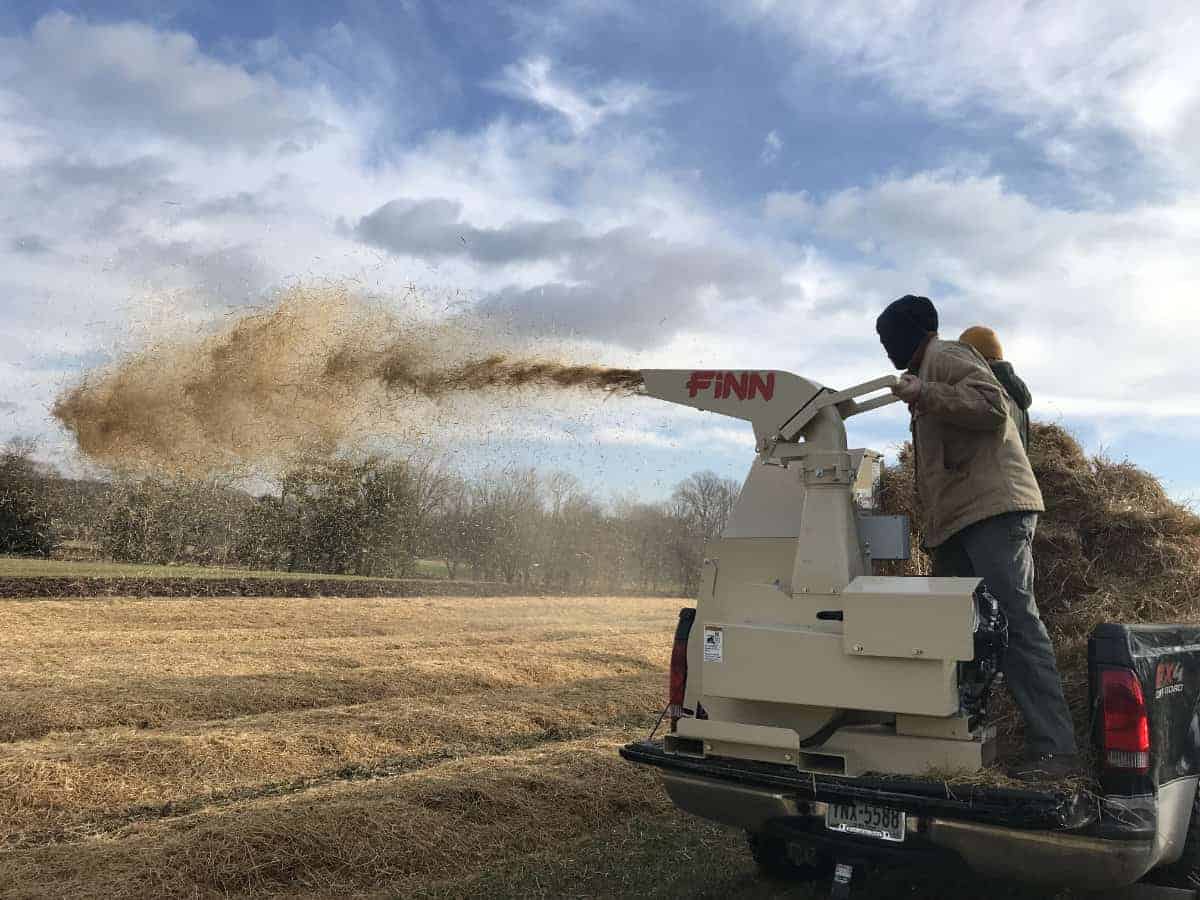
Share this article!
The straw blower is the foundation of FINN Corporation. When Charles Finn invented a machine that chopped and applied straw as mulching over new seedlings, it was the beginning of an innovative company dedicated to helping contractors find Smarter Ways to Work. While FINN has since then developed new machines like the hydroseeder and material blower, the straw blower continues to deliver high quality results for landscapers, construction contractors and farmers alike.
Straw blowers are used for more than just spreading straw over new grass seeds. Anytime straw is needed, a straw blower is capable of shredding and spreading it quickly and efficiently. Let’s take a look at some of the many ways these versatile, valuable machines are used.
Seed Protection
The original purpose of the straw blower was to protect freshly seeded soil. During the road construction boom after World War II, Charles Finn developed the straw blower to offer landscapers increased efficiency and profit. Instead of applying straw by hand over the soil on the side of miles of new highway, the straw blower delivered smooth, reliable power to spread straw evenly and effectively.
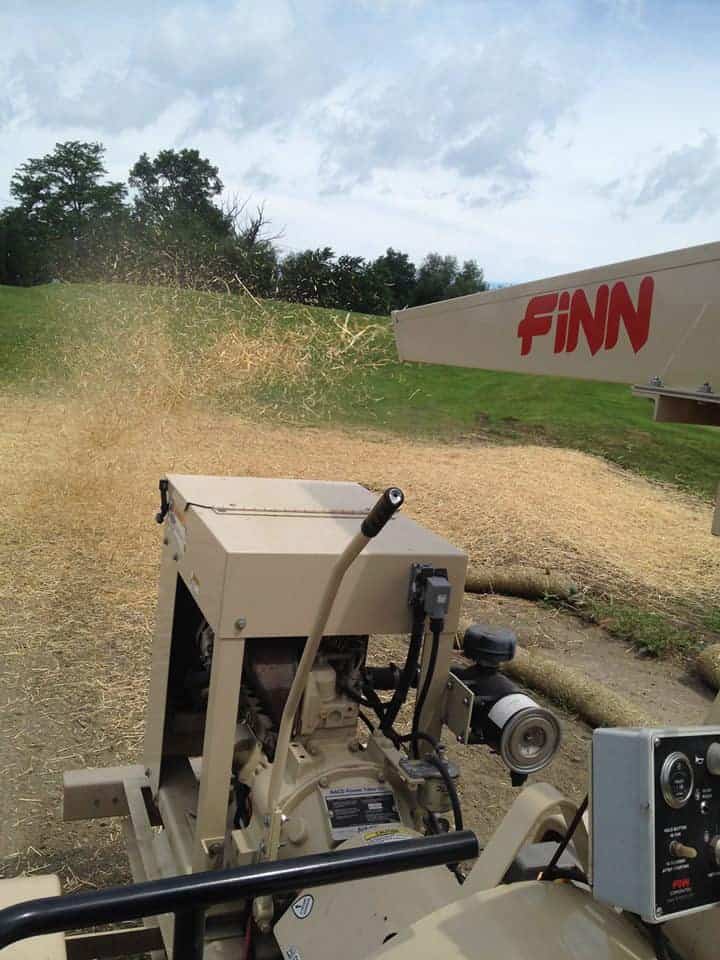
Raindrop Soil Erosion Protection
Raindrop erosion occurs when raindrops displace soil. It’s the first step in the erosion process and can cause dirt to move nearly five feet from the impact site. Raindrop erosion not only reduces the productivity of the land by removing nutrient-rich top soil, it also degrades the water quality of rivers, lakes and ponds.
Adding a layer of straw with a straw blower to bare soil can protect the ground from erosion and promote revegetation. The Soil Science Society of America Journal published a study about the effectiveness of straw preventing erosion on bare soil and found that an application of at least one ton per acre resulted in “essentially no erosion.”
Mud Mitigation
Heavy rains and dirt patches can lead to muddy, swamp-like conditions. The land may be unusable for many machines, and foot or animal traffic can destroy the soggy area. A quick, inexpensive option to cover mud and mitigate the potential damage is to cover it with straw from a straw blower. The straw will quickly absorb the moisture and allow for light foot traffic.
Keep in mind, straw is prone to holding in the moisture so it may take the area longer to dry when covered by straw. Additionally, straw may need multiple applications during rainy seasons.
Animal Bedding
Straw is a byproduct of farming. Farmers collect the stalks of cereal grains like wheat, rye, barley or oats following harvest and after the stalks have dried out. Straw is the leftover of hollowed-out stems of the grain plant. It is typically used as an animal bedding material on farms because it is effective and cheap.
While hay is moist and prone to molding, straw is dried out and provides plenty of cushioning on which animals can sleep. With little to no nutritional value, animals aren’t tempted to eat the straw. Using a straw blower, farmers can quickly spread new, fresh straw for animals.
Soil Stabilization
Just as straw is used to protect the ground from raindrop erosion, it is effective at stabilizing soil, as well. Soil stabilization is the act of altering the soil’s chemical or physical properties to increase its strength and control how much the soil shrinks or swells. This is done to enhance the soil’s ability to support roads and structural foundations.
According to the Pavement Preservation & Recycling Alliance (PRRA), “often, subgrade soils are too wet, exhibiting poor workability and lacking sufficient strength to support construction equipment.” The PRRA says contractors can save 20-40% by using straw compared to removing and replacing the material, as well as reduce the use of trucks to deliver materials to the job site and add up to 25 years of life extension for pavement jobs.
The International Journal of Advance Engineering and Research Development recently published a study examining the use of straw to reinforce soil stabilized by cement. Building upon earlier research that found straw was effective at reinforcing soil mixed with stabilizers, the study found soil mixed with 10% cement and 3% straw showed the best performance for soil stabilized for construction.
While this research was conducted in a tropical region of Pakistan and the results may not be suitable for all climates, it does illustrate the effectiveness of straw in stabilizing soil. Using a straw blower, contractors can quickly and efficiently spread the straw across the soil before mixing it and preparing the land for construction.
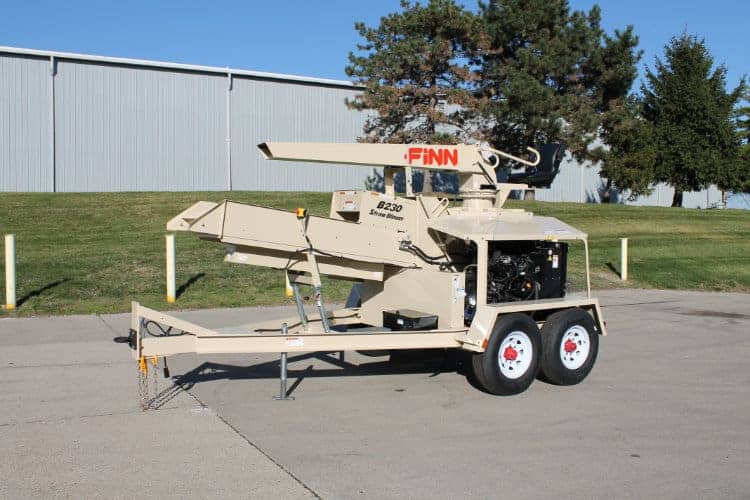
The Best Straw Blower for You
Straw blowers are time-tested machines capable of tackling jobs of all sizes, from residential lawns to massive mining sites. With some models capable of discharging 20 tons of straw per hour, FINN Straw Blowers deliver smooth, reliable power even in the most demanding conditions. With easy, one-handed control, operators can confidently work throughout the day without fatigue from handling the machine. FINN has been on the cutting edge of developing straw blowers since 1949. Let our team help you find the best straw blower for your situation. Visit our straw blower product page or contact your local dealer to learn more and find Smarter Ways to Work.
Folow Finn Corporation on Social
How to Lay Mulch Evenly – When & Why to Use a Mulch Blower
Understanding the best way to spread mulch evenly can mean the difference between a great-looking, environmentally-friendly landscape, and one that falls short in both areas. From spreading mulch basics to how to spread mulch evenly, and when to use a mulch blower to achieve the desired results, these landscaper insider tips can help elevate your next project’s aesthetics and help…
Bark & Mulch Blowing 101
One of the best ways to enhance soil composition, prevent erosion, and improve the aesthetics of any landscaping project is to utilize bark and mulch blowing. For our purposes, bark and mulch blowing are effectively the same thing, and can generally be used interchangeably. Bark and mulch are both great choices to prevent weed growth and invasion, improve soil quality…
Hydroseed vs. Sod vs. Grass Seed
If you’re starting a lawn from scratch, you’ve probably come across the three common methods for seeding: sod, grass seed, and hydroseed. In order to determine the best choice for your yard, you may want to ask yourself a few questions before you get started, and familiarize yourself with each of the processes so you can make the right choice…

